#PHP variable naming
Explore tagged Tumblr posts
Text
PHP Variables : Syntax, Types, Scope, and Best Practices
Learn all about PHP variables including syntax, data types, variable scope, and best practices. A beginner-friendly guide to mastering PHP variables with examples. PHP Variables – A Complete Guide for Beginners PHP (Hypertext Preprocessor) is a powerful server-side scripting language widely used for web development. One of the foundational concepts in PHP—and in any programming language—is…
#PHP array variable#PHP for beginners#PHP global variable#PHP local variable#PHP programming#PHP static variable#PHP string variable#PHP syntax#PHP tutorial#PHP variable example#PHP variable naming#PHP variable scope#PHP variable types#PHP variables
0 notes
Text
SysNotes devlog 3 - Ability to create a new profile
Welcome back to my SysNotes update! SysNotes is a system management app for people with DID, OSDD, and those who are otherwise plural.
(I will keep the intro text the same in all devlogs for context)
This devlog will be shorter than usual because I didn't want to lump it in with the next feature, which I expect will be quite long. In this devlog, I will add a way to create a new profile.
First Devlog (1) | Previous Devlog (2)
Quick Refactor before we jump in
"So I did some refactoring off-camera..." - originally, everything on the page was happening inside one component. I decided to split it up into the main page and the profile section, which is a new separate component. This will keep my code shorter and easier to maintain.
I also added a way to refer to each profile individually by their ID in the URL:
(Colin's profile is ID 4, which is shown in the URL)

I was also storing profile data as separate variables, which would be inconvenient to individually pass into the new main profile component. So I moved them all into one variable:
(old | new)
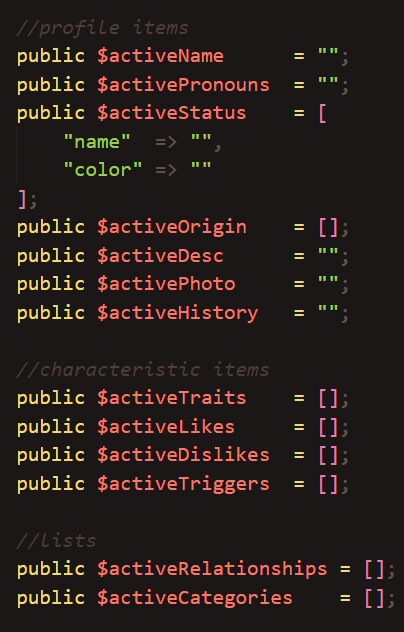
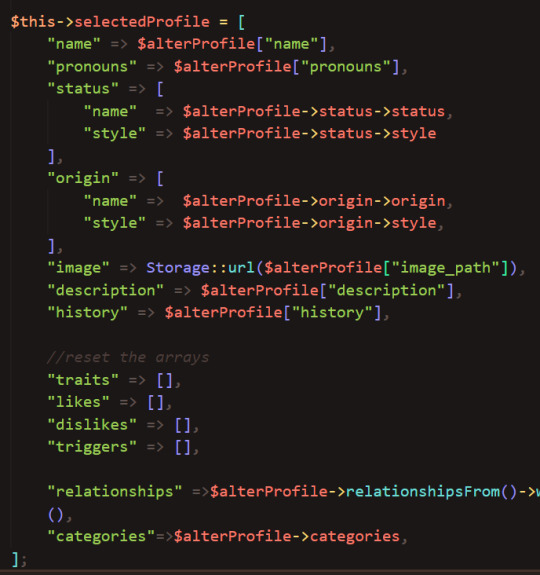
Design of the New Profile form
To be honest, I've been dreading this part since the beginning. I mean, how do I even lay this out? 💀
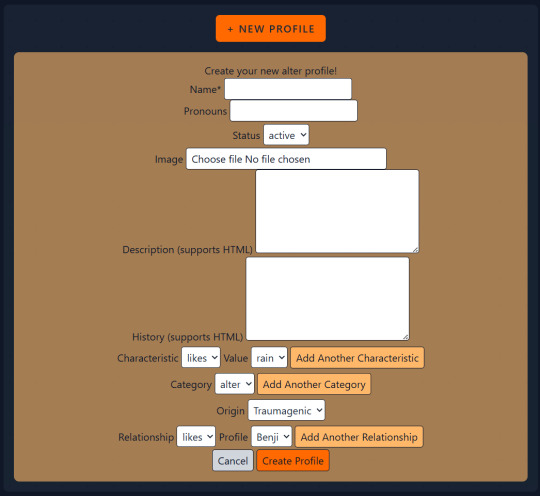
It is common for developers to avoid UI design because they are "coders not designers". I, for one, quite enjoy web design. Still, this task feels quite overwhelming to me. So, let's take this little mockup I made and turn it into something usable 💪
Too much stuff?
I think the biggest challenge here is the sheer number of inputs. And as the app grows, the number of inputs in this form will only increase.
The only mandatory input for a new profile is just their name. Therefore, the first step should be separating the Name field from the rest of the inputs.
The new and improved New Profile form is looking much better now:

...Yes, really! That's the whole form!
You are unlikely to know everything about an alter that has just split, so all those fields are completely unnecessary for an alter to be added to the list. Every other detail can be added later through the edit mode, where each field can be edited separately without needing one giant form.
Another big reason why I decided to forego the big form altogether is that the code for saving a new profile and the code for editing a profile would be almost exactly the same (including validation), and it wouldn't make sense to duplicate this code if I can just use it in one instance.
Saving a new profile
Let's add some validation to the input field to make sure that the user enters the name in a correct format.
As the Name is stored in the database as a string, it has the maximum length of 255 characters. Trying to save a longer name than this will cause errors, so we need to validate the input to make sure it's safe to insert into the database:

Here's what happens when I input a whole paragraph of Lorem Ipsum text and try to save it:

On the other hand, a shorter name saves just fine:

By the way, these flash messages are added in 2 ways: the success is a session message, and the error is an error stored separately by the validator. The flash messages originally have no styling, so I defined those myself using Tailwind's "@apply" for efficiency.
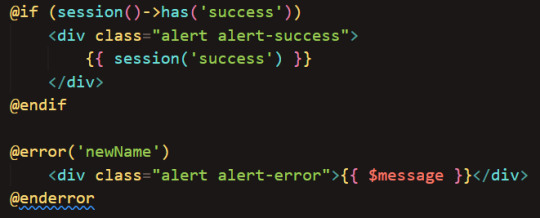
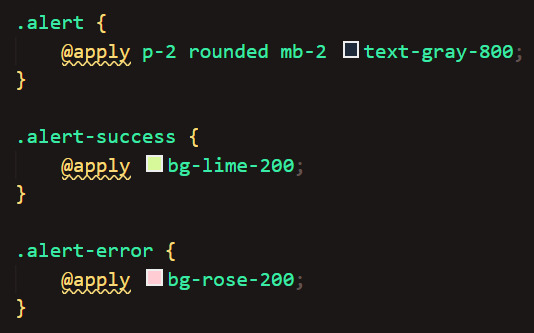
Once submitted, the name list automatically updates with our new profile:
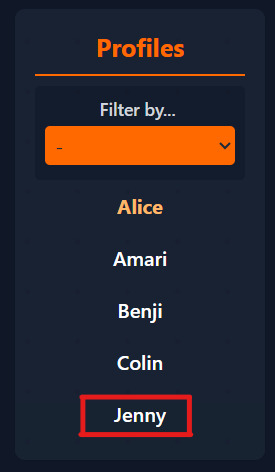
(And if I click cancel it just empties the input)

Okay, let's click on Jenny's profile to see what it looks like! ...Oh

This is because the code tries to access Jenny's status, but she doesn't have one yet, she only has a name!
(When I pull the data from the database, I'm trying to access a non-existent value)

(And when I display the values I got from the database, the display may break if the value is NULL)

(This error applies to all profile fields, not just status, however the app crashes after just the first error it comes across so the remaining errors are not shown)
This can easily fixed by using PHP's "isset()" and/or "empty()" function, which checks if a variable has a value:
(I'm using a ternary operator as a more compact alternative to if-else. it basically goes: "if this condition is true ? then do it : if not, do something else")

(And here I just check if these values are not blank before rendering them)

Success, Jenny's profile shows!
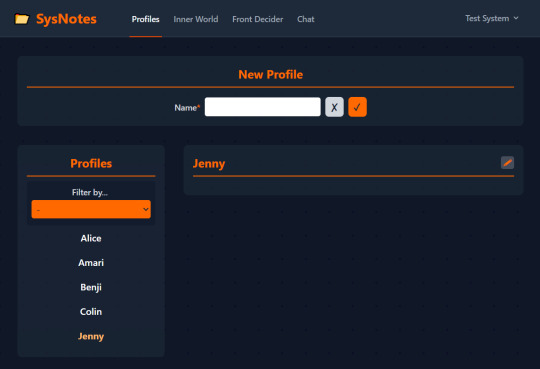
Now, we just have to populate this profile with data about Jenny, and to do that we'll need to be able to edit each field. I will work on this in the next devlog, as I expect this to take quite some time.
Thanks so reading! As always, any suggestions are welcome!
5 notes
·
View notes
Text
SQL Injection
perhaps, the direct association with the SQLi is:
' OR 1=1 -- -
but what does it mean?
Imagine, you have a login form with a username and a password. Of course, it has a database connected to it. When you wish a login and submit your credentials, the app sends a request to the database in order to check whether your data is correct and is it possible to let you in.
the following PHP code demonstrates a dynamic SQL query in a login from. The user and password variables from the POST request is concatenated directly into the SQL statement.
$query ="SELECT * FROM users WHERE username='" +$_POST["user"] + "' AND password= '" + $_POST["password"]$ + '";"
"In a world of locked rooms, the man with the key is king",
and there is definitely one key as a SQL statement:
' OR 1=1-- -
supplying this value inside the name parameter, the query might return more than one user.
most applications will process the first user returned, meaning that the attacker can exploit this and log in as the first user the query returned
the double-dash (--) sequence is a comment indicator in SQL and causes the rest of the query to be commented out
in SQL, a string is enclosed within either a single quote (') or a double quote ("). The single quote (') in the input is used to close the string literal.
If the attacker enters ' OR 1=1-- - in the name parameter and leaves the password blank, the query above will result in the following SQL statement:
SELECT * FROM users WHERE username = '' OR 1=1-- -' AND password = ''
executing the SQL statement above, all the users in the users table are returned -> the attacker bypasses the application's authentication mechanism and is logged in as the first user returned by the query.
The reason for using -- - instead of -- is primarily because of how MySQL handles the double-dash comment style: comment style requires the second dash to be followed by at least one whitespace or control character (such as a space, tab, newline, and so on). The safest solution for inline SQL comment is to use --<space><any character> such as -- - because if it is URL-encoded into --%20- it will still be decoded as -- -.
4 notes
·
View notes
Text
Complete PHP Tutorial: Learn PHP from Scratch in 7 Days
Are you looking to learn backend web development and build dynamic websites with real functionality? You’re in the right place. Welcome to the Complete PHP Tutorial: Learn PHP from Scratch in 7 Days — a practical, beginner-friendly guide designed to help you master the fundamentals of PHP in just one week.
PHP, or Hypertext Preprocessor, is one of the most widely used server-side scripting languages on the web. It powers everything from small blogs to large-scale websites like Facebook and WordPress. Learning PHP opens up the door to back-end development, content management systems, and full-stack programming. Whether you're a complete beginner or have some experience with HTML/CSS, this tutorial is structured to help you learn PHP step by step with real-world examples.
Why Learn PHP?
Before diving into the tutorial, let’s understand why PHP is still relevant and worth learning in 2025:
Beginner-friendly: Easy syntax and wide support.
Open-source: Free to use with strong community support.
Cross-platform: Runs on Windows, macOS, Linux, and integrates with most servers.
Database integration: Works seamlessly with MySQL and other databases.
In-demand: Still heavily used in CMS platforms like WordPress, Joomla, and Drupal.
If you want to build contact forms, login systems, e-commerce platforms, or data-driven applications, PHP is a great place to start.
Day-by-Day Breakdown: Learn PHP from Scratch in 7 Days
Day 1: Introduction to PHP & Setup
Start by setting up your environment:
Install XAMPP or MAMP to create a local server.
Create your first .php file.
Learn how to embed PHP inside HTML.
Example:
<?php echo "Hello, PHP!"; ?>
What you’ll learn:
How PHP works on the server
Running PHP in your browser
Basic syntax and echo statement
Day 2: Variables, Data Types & Constants
Dive into PHP variables and data types:
$name = "John"; $age = 25; $is_student = true;
Key concepts:
Variable declaration and naming
Data types: String, Integer, Float, Boolean, Array
Constants and predefined variables ($_SERVER, $_GET, $_POST)
Day 3: Operators, Conditions & Control Flow
Learn how to make decisions in PHP:
if ($age > 18) { echo "You are an adult."; } else { echo "You are underage."; }
Topics covered:
Arithmetic, comparison, and logical operators
If-else, switch-case
Nesting conditions and best practices
Day 4: Loops and Arrays
Understand loops to perform repetitive tasks:
$fruits = ["Apple", "Banana", "Cherry"]; foreach ($fruits as $fruit) { echo $fruit. "<br>"; }
Learn about:
for, while, do...while, and foreach loops
Arrays: indexed, associative, and multidimensional
Array functions (count(), array_push(), etc.)
Day 5: Functions & Form Handling
Start writing reusable code and learn how to process user input from forms:
function greet($name) { return "Hello, $name!"; }
Skills you gain:
Defining and calling functions
Passing parameters and returning values
Handling HTML form data with $_POST and $_GET
Form validation and basic security tips
Day 6: Working with Files & Sessions
Build applications that remember users and work with files:
session_start(); $_SESSION["username"] = "admin";
Topics included:
File handling (fopen, fwrite, fread, etc.)
Reading and writing text files
Sessions and cookies
Login system basics using session variables
Day 7: PHP & MySQL – Database Connectivity
On the final day, you’ll connect PHP to a database and build a mini CRUD app:
$conn = new mysqli("localhost", "root", "", "mydatabase");
Learn how to:
Connect PHP to a MySQL database
Create and execute SQL queries
Insert, read, update, and delete (CRUD operations)
Display database data in HTML tables
Bonus Tips for Mastering PHP
Practice by building mini-projects (login form, guest book, blog)
Read official documentation at php.net
Use tools like phpMyAdmin to manage databases visually
Try MVC frameworks like Laravel or CodeIgniter once you're confident with core PHP
What You’ll Be Able to Build After This PHP Tutorial
After following this 7-day PHP tutorial, you’ll be able to:
Create dynamic web pages
Handle form submissions
Work with databases
Manage sessions and users
Understand the logic behind content management systems (CMS)
This gives you the foundation to become a full-stack developer, or even specialize in backend development using PHP and MySQL.
Final Thoughts
Learning PHP doesn’t have to be difficult or time-consuming. With the Complete PHP Tutorial: Learn PHP from Scratch in 7 Days, you’re taking a focused, structured path toward web development success. You’ll learn all the core concepts through clear explanations and hands-on examples that prepare you for real-world projects.
Whether you’re a student, freelancer, or aspiring developer, PHP remains a powerful and valuable skill to add to your web development toolkit.
So open up your code editor, start typing your first <?php ... ?> block, and begin your journey to building dynamic, powerful web applications — one day at a time.

0 notes
Text
PHP $ and $$ Variables
Understanding PHP $ Sign
The PHP parser uses the dollar sign, a reserved symbol, to figure out what you've specified as a compile-time variable. Certain words and symbols have been set aside in PHP so that the parser may analyse the code script and identify code blocks by establishing explicit rules. These guidelines, or reserved names, are a means of preventing naming conflicts between your classes, variables, and fundamental PHP functions, among other things. PHP separates itself from the rest of the string (script) using the dollar sign in its syntax. Symbols (Sigil's) were employed to display variables and their scope, drawing influence from Perl, which PHP shared many characteristics with in its early days.

0 notes
Text
Sweep AI: The Future of Automated Code Refactoring
Introduction to Sweep AI
In today’s digital age, writing and maintaining clean code can wear developers down. Deadlines pile up, bugs pop in, and projects often fall behind. That’s where Sweep AI steps in. It acts as a reliable coding assistant that saves time, boosts productivity, and supports developers by doing the heavy lifting in coding tasks.
This article breaks down everything about Sweep AI, how it helps with code automation, and why many developers choose it as their go-to AI tool.
Understanding Sweep AI
Sweep AI is an open-source AI-powered tool that behaves like a junior developer. It listens to your needs, reads your code, and writes or fixes it accordingly. It can turn bug reports into actual code fixes without needing constant manual guidance.
More importantly, Sweep AI does not cost a dime to start. It’s ideal for teams and solo developers who want to move fast without sacrificing code quality.
How Sweep AI Works
Sweep AI works in a simple yet powerful way. Once a developer writes a feature request or a bug report, the AI jumps into action. Here’s what it usually does:
Reads the existing code
Plans the changes intelligently
Writes pull requests automatically
Updates based on comments or suggestions
Sweep AI also uses popularity ranking to understand which parts of your repository matter the most. It responds to feedback and works closely with developers throughout the code improvement process.
Types of Refactoring Sweeps AI Can Handle
Sweeps AI does not just work on surface-level improvements. It digs deep into the code. Some of its main capabilities include:
Function extraction: breaking large functions into smaller, clearer ones
Renaming variables: making names more meaningful
Removing dead code: getting rid of unused blocks
Code formatting: applying consistent style and spacing
It can also detect complex issues like duplicate logic across files, risky design patterns, and nested loops that slow down performance.
Why Developers Are Turning to Sweeps AI
Many developers use Sweeps AI because it:
Saves time
Reduces human error
Maintains consistent coding standards
Improves software quality
Imagine a junior developer who must refactor 500 lines of spaghetti code. That person might take hours or even days to clean it up. With Sweeps AI, the job could be done in minutes.
Step-by-Step Guide to Start Using Sweep AI
You don’t need to be a tech wizard to get started with Sweep AI. Here are two easy methods:
Install the Sweep AI GitHub App Connects to your repository and starts working almost immediately.
Self-host using Docker Ideal for developers who want more control or need to run it privately.
Sweep AI also shares helpful guides, video tutorials, and documentation to walk users through each step.
The Present and the Future
Right now, Sweeps AI already supports languages like Python, JavaScript, TypeScript, and Java. But the roadmap includes support for C++, PHP, and even legacy languages like COBOL. That shows just how ambitious the project is.
In the coming years, we might see Sweeps AI integrated into platforms like GitHub, VS Code, and JetBrains IDES by default. That means you won’t need to go out of your way to use it will be part of your everyday coding workflow.
How Much Does Sweep AI Cost?
Sweep AI offers a flexible pricing model:
Free Tier – Unlimited GPT-3.5 tickets for all users.
Plus Plan – $120/month includes 30 GPT-4 tickets for more advanced tasks.
GPT-4 Access – Requires users to connect their own Openai API key (charges may apply).
Whether you’re working on a startup project or a large codebase, there’s a plan that fits.
Is Sweep AI Worth It?
Absolutely. Sweep AI is more than just another coding assistant it’s a valuable teammate. It understands what you need, helps you fix problems faster, and lets you focus on what really matters: building great products.
Thanks to its smart features and developer-friendly design, Sweep AI stands out as one of the top AI tools for modern software teams. So, if you haven’t tried it yet, now’s a good time to dive in and take advantage of what it offers.
Frequently Asked Questions
Q: Who is the founder of Sweep AI?
Sweep AI was co-founded by William Suryawan and Kevin Luo, two AI engineers focused on making AI useful for developers by automating common tasks in GitHub.
Q: Is there another AI like Chatgpt?
Yes, there are several AIS similar to Chatgpt, including Claude, Gemini (by Google), Cohere, and Anthropic’s Claude. However, Sweep AI is more focused on code generation and GitHub integrations.
Q: Which AI solves GitHub issues?
Sweep AI is one of the top tools for automatically solving GitHub issues by generating pull requests based on bug reports or feature requests. It acts like a junior developer who understands your project.
Q: What is an AI agent, and how does it work?
An AI agent is a software program that performs tasks autonomously using artificial intelligence. It receives input (like code requests), makes decisions, and performs actions (like fixing bugs or writing code) based on logic and data.
Q: Who is the CEO of Sweep.io?
As of the latest information, Kevin Luo serves as the CEO of Sweep.io, focusing on making AI development tools smarter and more accessible.
0 notes
Text
PHP Tutorial: Your First Guide to Web Development with PHP
Are you ready to start your journey into the world of web development? If you're searching for a dynamic and beginner-friendly way to build powerful websites, you’ve probably come across PHP. This PHP Programming Language Tutorial by Tpoint Tech is designed to be your first step into the world of backend development, giving you the knowledge you need to get started—even if you’ve never written a line of code before.
What is PHP?
PHP, which stands for "Hypertext Preprocessor," is a widely-used open-source scripting language primarily suited for web development. Unlike HTML and CSS, which control how things look on a website, PHP is all about functionality—handling forms, connecting to databases, generating dynamic page content, and more.
It is used by some of the biggest names on the web, including Facebook and WordPress. In fact, more than 75% of websites that use a server-side programming language rely on PHP. This makes Learning PHP a smart and practical choice for aspiring developers.
Why Learn PHP?
One of the greatest advantages of PHP is its simplicity. It's an accessible language for beginners, yet powerful enough for professionals. Whether you're building a simple contact form or a complex content management system, PHP provides the flexibility and tools needed to succeed.
Here are a few reasons why Learning PHP is a solid investment in your web development career:
Beginner-Friendly: PHP has a gentle learning curve, which means you can get up and running quickly.
Vast Community Support: Thanks to its longevity and popularity, there are countless tutorials, forums, and resources available.
Cross-Platform Compatibility: PHP runs on virtually every operating system including Windows, Linux, and macOS.
Database Integration: PHP works seamlessly with databases like MySQL, which is essential for creating data-driven websites.
Fast and Efficient: PHP scripts execute quickly and efficiently, making your websites faster and more responsive.
How PHP Fits Into Web Development
To fully understand PHP’s role, it helps to know how websites work. When you visit a webpage, your browser sends a request to a server. If the page is built with PHP, the server processes the PHP code and then sends the resulting output (usually HTML) back to your browser. This is what makes PHP a “server-side” language—it does its work behind the scenes.
When paired with front-end technologies like HTML, CSS, and JavaScript, PHP becomes part of a powerful toolkit for building modern, interactive websites.
What You’ll Learn in This PHP Programming Language Tutorial
At Tpoint Tech, we believe in making learning simple, structured, and enjoyable. Our PHP Programming Language Tutorial is crafted to guide you step-by-step through the essentials of PHP development, even if you’ve never programmed before.
Here's an overview of what our tutorial covers:
Understanding the Basics: Learn about variables, data types, and how PHP fits into your HTML pages.
Control Structures: Master how to use conditions and loops to control the logic of your programs.
Forms and User Input: Learn how PHP handles user interactions like form submissions.
Working with Files and Databases: Get introduced to reading, writing, and organizing data with PHP.
Building Functional Web Applications: Apply what you’ve learned to create dynamic and real-world applications.
Throughout the tutorial, Tpoint Tech ensures the concepts are explained in clear, plain language with real-life analogies to make technical details easy to grasp.
No Coding Required to Get Started
You might be surprised to know that Learning PHP doesn’t have to start with writing code right away. At Tpoint Tech, we encourage learners to first build a strong understanding of concepts, structure, and logic before jumping into the syntax. This helps you develop a clearer mental model of how web technologies work together and makes the learning process smoother when you do begin coding.
Even without coding, you can explore how PHP-driven websites operate, analyze how server responses change with different inputs, and understand the purpose of various PHP components.
Final Thoughts
Learning PHP opens up a world of possibilities for anyone interested in web development. From enhancing static web pages to building robust web applications, PHP remains a staple technology in the developer's toolkit. At Tpoint Tech, we are excited to be part of your journey and provide the guidance, support, and resources needed to turn you from a beginner into a confident PHP developer.
So whether you're aiming to become a freelance developer, improve your resume, or build your own online projects, starting with a well-structured PHP Programming Language Tutorial like the one offered by Tpoint Tech is a decision you won’t regret.

0 notes
Text
WooCommerce Give Products nulled plugin 1.2.0

Download WooCommerce Give Products Nulled Plugin for Free Looking to enhance your WooCommerce store with a powerful gifting solution? The WooCommerce Give Products nulled plugin is your ultimate tool for sending products to your customers for free. Whether you're rewarding loyal users or offering free samples, this plugin simplifies the process and adds a new layer of functionality to your online store—absolutely free when you download it from our site! What Is the WooCommerce Give Products Nulled Plugin? The WooCommerce Give Products is a premium tool developed for WooCommerce that allows store owners to "gift" products directly to customers without requiring them to go through the usual checkout process. It’s perfect for promotions, giveaways, or loyalty rewards, offering a streamlined solution for sending products directly to a customer’s account. Unlike traditional giveaway plugins, this one integrates directly with your WooCommerce backend, ensuring that the gifting process feels native, seamless, and professional. Best of all, you can download nulled WordPress themes and plugins like this without spending a penny. Technical Specifications Plugin Name: WooCommerce Give Products Current Version: Latest (Nulled & Fully Functional) Compatibility: WordPress 5.0+ and WooCommerce 4.0+ License: GPL (General Public License) Files Included: PHP, CSS, JavaScript, Language Files Features and Benefits One-Click Product Gifting: Easily send products directly to any registered customer. Improved Customer Retention: Reward loyal customers and build trust by giving away premium products. Works with All Product Types: Compatible with simple, variable, and downloadable products. Bulk Actions: Send multiple products to multiple users at once using intuitive admin controls. Email Notifications: Automatically notify users when they’ve received a gifted product. How Can You Use WooCommerce Give Products Nulled Plugin? Whether you’re running a promotion or looking to build goodwill with your user base, the WooCommerce Give Products gives you full control over product giveaways. You can create campaigns that surprise and delight your customers, drive engagement, and even test new products by distributing them selectively. It's a strategic tool for eCommerce success. Easy Installation Guide Download the WooCommerce Give Products nulled plugin from our website. Go to your WordPress dashboard and navigate to Plugins > Add New. Click on Upload Plugin and select the downloaded ZIP file. Click Install Now, then activate the plugin. Start gifting products directly from your WooCommerce admin panel! FAQs Is the WooCommerce Give Products nulled plugin safe to use? Yes! All our nulled plugins are thoroughly scanned and tested for safety. We ensure no malicious code is present in any downloads. Will customers know the product was gifted? Yes, the plugin sends out an automatic email notification letting the customer know they’ve received a free product from your store. Does this plugin support variable products? Absolutely. The WooCommerce Give Products nulled plugin works flawlessly with variable, simple, and even digital products. Can I use it on multiple websites? Since it's GPL licensed, you're free to use it across unlimited sites with no restrictions. Get More with the Porto Theme If you're building an optimized eCommerce store, pair this plugin with the Porto NULLED theme for a high-performance, elegant look and feel. It’s the perfect combination for WordPress entrepreneurs who want to maximize results without breaking the bank. Conclusion The WooCommerce Give Products is a must-have for any store owner who values smart marketing and customer engagement. With seamless integration, a user-friendly interface, and robust functionality, this plugin empowers you to give back to your users and grow your brand at the same time. Don’t miss out—download it today and start gifting smarter!
0 notes
Link
#Automation#cloud#configuration#containerization#deploy#DevOps#Docker#feedaggregator#FreshRSS#Linux#Monitoring#news#open-source#Performance#Privacy#RSSreader#self-hosted#Server#systemadministration#updates#webapplication
0 notes
Text
Prevent XSS Attacks in Symfony Applications
Cross-Site Scripting (XSS) remains one of the most exploited web vulnerabilities, especially in modern PHP frameworks like Symfony. In this post, we'll explore how XSS vulnerabilities can creep into Symfony apps, how attackers exploit them, and how to fix or prevent these issues with practical code examples.

You’ll also see how you can scan your site for free using the Website Vulnerability Scanner, which helps detect XSS vulnerabilities and other issues automatically.
🔍 What is Cross-Site Scripting (XSS)?
Cross-Site Scripting (XSS) is a type of vulnerability that allows attackers to inject malicious JavaScript into webpages viewed by other users. The goal? Stealing cookies, session tokens, or redirecting users to malicious sites.
There are three common types:
Stored XSS – Malicious script is permanently stored on the target server.
Reflected XSS – Script is reflected off a web server, often in search results or error messages.
DOM-based XSS – Happens entirely on the client side using JavaScript.
⚠️ XSS in Symfony: How it Happens
Even though Symfony is a robust framework, developers may still accidentally introduce XSS vulnerabilities if they don’t properly escape output or trust user input blindly.
✅ Vulnerable Example: Output Without Escaping
// src/Controller/SampleController.php public function unsafeOutput(Request $request): Response { $name = $request->query->get('name'); return new Response("<h1>Hello, $name!</h1>"); }
If a user visits:
http://example.com?name=<script>alert('XSS')</script>
This JavaScript will execute in the browser. That’s a textbook XSS vulnerability.
🛡️ Secure Coding: Escaping Output in Symfony
Symfony uses Twig by default, which automatically escapes variables. But developers can override this behavior.
✅ Safe Example with Twig
{# templates/welcome.html.twig #} <h1>Hello, {{ name }}</h1>
This is safe because Twig escapes {{ name }} by default. But if you do this:
<h1>Hello, {{ name|raw }}</h1>
You disable escaping, making it vulnerable again. Avoid using |raw unless you're 100% sure the content is safe.
✋ Validating and Sanitizing Input
Always sanitize and validate input using Symfony’s form and validator components.
✅ Example Using Symfony Validator
use Symfony\Component\Validator\Constraints as Assert; use Symfony\Component\Validator\Validation; $validator = Validation::createValidator(); $violations = $validator->validate($userInput, [ new Assert\NotBlank(), new Assert\Regex([ 'pattern' => '/^[a-zA-Z0-9\s]*$/', 'message' => 'Only alphanumeric characters allowed.' ]), ]); if (count($violations) > 0) { // Handle validation errors }
🧪 Detecting XSS Automatically with a Free Tool
Want to find XSS vulnerabilities without writing a line of code?
Use the free security scanner by Pentest Testing Corp for a Website Security test. It scans your website for XSS, SQLi, Clickjacking, and many other issues.
🖼️ Screenshot of the Website Security Checker homepage

Screenshot of the free tools webpage where you can access security assessment tools.
📄 Sample XSS Detection Report
After scanning, you’ll get a detailed vulnerability report to check Website Vulnerability. Here’s a sample:
🖼️ Screenshot of a vulnerability assessment report

An Example of a vulnerability assessment report generated with our free tool, providing insights into possible vulnerabilities.
This includes affected URLs, vulnerability types, severity levels, and remediation suggestions.
🔗 Learn More About Web Security
Visit our blog at Pentest Testing Corp. for more insights, tutorials, and vulnerability write-ups.
✅ Final Checklist for Preventing XSS in Symfony
✅ Use Twig’s auto-escaping.
✅ Never use |raw unless absolutely necessary.
✅ Validate user input with Symfony's Validator.
✅ Sanitize dynamic content before outputting.
✅ Scan your app regularly with tools like free.pentesttesting.com.
Cross-Site Scripting is dangerous, but with a few best practices and tools, you can keep your Symfony app safe. Try out our website vulnerability scanner and harden your web applications today!
1 note
·
View note
Text
Future of PHP: What’s Coming in PHP 9? – Discuss upcoming features and trends in PHP development
Introduction
Despite numerous predictions about its decline, PHP continues to be a cornerstone of web development. From powering small personal blogs to massive social media platforms, PHP has proven its resilience and adaptability. With the upcoming release of PHP 9.0, developers are eager to explore the new features and improvements that will shape the future of PHP development Services.
While the official release date of PHP 9.0 remains unknown, community discussions and leaks provide insight into the major changes and enhancements expected. In this post, we will delve into the evolution of PHP, its key features, and why it remains an essential tool for developers worldwide. Additionally, we will discuss upcoming features and trends in PHP development, offering insights into the direction PHP is heading.
Evolution of PHP: A Brief Overview
PHP (Hypertext Preprocessor) has come a long way since its inception in 1994. Originally created as a simple scripting language for building dynamic web pages, PHP has evolved into a robust and powerful language that powers a significant portion of the internet.
PHP 5
Introduced object-oriented programming (OOP) features.
Implemented PDO (PHP Data Objects) for secure database interactions.
Improved exception handling and memory management.
PHP 7
Boosted performance with the Zend Engine 3.0.
Introduced scalar type declarations and return type hints.
Implemented null coalescing operator (??).
Improved error handling with Throwable exceptions.
PHP 8
Brought Just-In-Time (JIT) compilation for significant performance improvements.
Introduced Union Types, Match Expression, Named Arguments, and Attributes.
Implemented Constructor Property Promotion to reduce boilerplate code.
Now, with PHP 9 on the horizon, what can we expect?
Key Features of PHP 8 That Paved the Way for PHP 9
Before diving into PHP 9.0, let's briefly review some of the most impactful features introduced in PHP 8:
1) Just-In-Time (JIT) Compiler
Performance: JIT compilation allows code to be compiled at runtime, significantly improving execution speed for computationally intensive tasks.
Impact: While not drastically enhancing standard web applications, JIT opens doors for PHP’s use in fields like scientific computing and machine learning.
2) Union Types
Flexibility: Allows functions to accept multiple data types, enhancing type safety and robustness.
Example: function foo(int|float $number) { /* ... */ }
3) Attributes (Annotations)
Meta-programming: Introduces structured metadata for classes, methods, and properties.
Usage: Simplifies code annotation, improving integration with frameworks and tools.
4) Match Expression
Simplicity: Provides a more readable alternative to switch statements.
Example:
$result = match ($value) {
1 => 'one',
2 => 'two',
default => 'other',
};
5) Constructor Property Promotion
Efficiency: Reduces boilerplate code for class property initialization.
Example:
class Point {
public function __construct(private int $x, private int $y) {}
}
6) Nullsafe Operator
Error Handling: Reduces null checks, making code more concise.
Example: $country = $session?->user?->getAddress()?->country;
Anticipated Features in PHP 9
As PHP 9 is still under development, specific features may change. However, based on leaks and discussions, here are the expected improvements:
1) Removal of Deprecated Features
PHP 9.0 will eliminate features deprecated in PHP 8.1 - 8.4, streamlining the language and enhancing maintainability.
2) Transformation of Warnings to Errors
Warnings for undefined variables and properties will be converted into errors, demanding more precise coding practices.
3) Deprecated Dynamic Properties
Dynamic properties, deprecated in PHP 8.2, will now trigger ErrorException, enforcing structured coding practices.
4) New Random Extension
A new random number generator is being introduced, improving performance, security, and simplicity.
5) Standalone Types for null, true, and false
PHP 9.0 will recognize null, true, and false as standalone types, enhancing type precision.
6) Disjunctive Normal Form (DNF) Types
DNF types will enable complex combinations of union and intersection types, making PHP's type system more powerful.
7) Constants in Traits
PHP 9.0 will allow traits to define constants, expanding their capabilities for reusable code blocks.
8) Redact Sensitive Parameters in Backtraces
A crucial security improvement, this feature prevents sensitive data from being exposed in error backtraces.
9) Enhancements in Enum Property Fetching
PHP 9.0 will simplify the retrieval of enum properties in constant expressions, making enums more useful.
10) Additional Changes
Changes to return types in DateTime methods.
Deprecation of utf8_encode() and utf8_decode().
Locale-insensitive strtolower() and strtoupper().
Signature changes in SPL methods.
Introduction of "n" modifier in PCRE library.
Changes in ODBC username and password escaping.
Deprecation of ${} string interpolation.
Trends in PHP Development
1) Increased Use of Asynchronous Programming
PHP developers are exploring solutions like Swoole and ReactPHP to handle asynchronous tasks, improving performance in real-time applications.
2) Serverless PHP
With the rise of serverless computing, PHP is being adapted for FaaS (Functions as a Service) platforms, allowing developers to build scalable applications without managing infrastructure.
3) Enhanced Security Measures
PHP continues to implement stricter security protocols, focusing on data protection, encryption, and threat mitigation.
4) Microservices and API-First Development
Many PHP developers are shifting toward microservices and API-driven architectures, leveraging PHP frameworks like Laravel and Symfony to build efficient backend solutions.
The PHP Foundation's Role
The PHP Foundation plays a key role in guiding PHP's future, ensuring stability and funding core development. Their efforts, including initiatives like the Advisory Board and GitHub Sponsors, foster community engagement and ensure PHP's continued evolution.
Conclusion
PHP continues to evolve, adapting to modern web development needs while maintaining its flexibility. PHP 9.0 builds on the strong foundation of PHP 8, offering further performance improvements, enhanced asynchronous programming capabilities, a more robust type system, and better error handling.
While we await its official release, PHP 9.0 is shaping up to be a significant upgrade that will empower developers to build more efficient, secure, and scalable applications.
Stay tuned for more updates on PHP 9 and its impact on the web development landscape, as well as emerging trends shaping the future of PHP development.
Resource: What’s Coming in PHP 9? – Discuss upcoming features and trends in PHP development
0 notes
Text
PHP Variables : Syntax, Types, Scope, and Best Practices
Learn all about PHP variables including syntax, data types, variable scope, and best practices. A beginner-friendly guide to mastering PHP variables with examples. PHP Variables – A Complete Guide for Beginners PHP (Hypertext Preprocessor) is a powerful server-side scripting language widely used for web development. One of the foundational concepts in PHP—and in any programming language—is…
#PHP array variable#PHP for beginners#PHP global variable#PHP local variable#PHP programming#PHP static variable#PHP string variable#PHP syntax#PHP tutorial#PHP variable example#PHP variable naming#PHP variable scope#PHP variable types#PHP variables
0 notes
Text
Erweiterte Portale in FileMaker: Liste mit PHP und Web Viewer
Erweiterte Portale in FileMaker: Anlagenliste mit PHP und Web Viewer FileMaker ist ein vielseitiges Werkzeug für Datenbankanwendungen. Doch manchmal stoßen wir an technische Grenzen, wie die fehlende Möglichkeit, innerhalb eines Portals ein weiteres Portal zu platzieren. Diese Einschränkung können wir mit PHP und einem Web Viewer umgehen. In diesem Blog zeigen wir, wie du Anlagen zu einem Auftrag in einem Popover-Button darstellen kannst – inklusive interaktiver Buttons, die FileMaker-Scripts ausführen. Somit wirst Du in die Lage versetzt einen Datensatz auch in FileMaker anzusprechen und nicht nur den WebViewer zur Anzeige zu nutzen. In Meinem Beispiel, gehe ich von Aufträgen aus. Diese werden über ein Portal angezeigt. Jeder Auftrag kann mehrere Anlagen, bei meinem derzeitigen Kunden, sind es halt Anlagen im Bereich der Wasserversorgung. Das Ziel 1. Anzeigen der Anlagen eines Auftrags: Eine dynamische Liste von Anlagen, dargestellt in einem Web Viewer. 2. Interaktive Aktionen: Buttons, die ein FileMaker-Script starten, um die jeweilige Anlage anzuzeigen. Lösung: FileMaker + PHP 1. Datenübergabe von FileMaker an PHP Der erste Schritt ist, die relevanten Daten – z. B. eine Liste von Anlagen – an ein PHP-Script zu übergeben. Dies geschieht mit einem FileMaker-Script, das die Web Viewer-URL dynamisch setzt: Set Variable [ $auftragID ; Aufträge::ID ] Set Variable [ $anlagenListe ; Austauschen ( List ( Anlagen::AnlagenID ) ; "¶" ; "|" ) ] Set Variable [ $url ; "https://deine-webseite.de/anlagenanzeige.php?auftrag=" & $auftragID & "&anlagen=" & $anlagenListe ] Set Web Viewer [ Object Name: "WebViewer_Anlagen" ; URL: $url ] Es ist natürlich auch möglich dem WebViewer Dynamisch eine Globale Variable zu übergeben. Dann sage ich einfach setze Variable $$WebViewer0 $url. Nun benötigen wir natürlich noch ein PHP Script mit der beispielhaften Bezeichnung, -anlagenanzeige.php-. Dieses muss nach Erstellung auf den entsprechenden Server geladen werden. ```php <?php // Daten aus der URL übernehmen $auftragID = $_GET['auftrag'] ?? ''; $anlagenListe = $_GET['anlagen'] ?? ''; $anlagenArray = explode('|', $anlagenListe); // Sicherheitsmaßnahmen $auftragID = htmlspecialchars($auftragID, ENT_QUOTES, 'UTF-8'); $anlagenArray = array_map(function($anlage) { return htmlspecialchars($anlage, ENT_QUOTES, 'UTF-8'); }, $anlagenArray); ?> <!DOCTYPE html> Anlagen zu Auftrag <?= $auftragID ?>
body { font-family: Arial, sans-serif; margin: 20px; } .anlage { margin: 10px 0; padding: 10px; border: 1px solid #ddd; } .anlage-btn { padding: 5px 10px; background-color: #4285F4; color: white; border: none; cursor: pointer; }
Anlagen zu Auftrag <?= $auftragID ?>
<?php if (!empty($anlagenArray)): ?> <?php foreach ($anlagenArray as $anlage): ?>
Anlage ID: <?= $anlage ?>
')">Anlage öffnen
<?php endforeach; ?> <?php else: ?>
Keine Anlagen gefunden.
<?php endif; ?> function openInFileMaker(anlageID) { const fileMakerUrl = `fmp://$/DeineDatenbank?script=AnlageAnzeigen¶m=${encodeURIComponent(anlageID)}`; window.location.href = fileMakerUrl; } ``` Dieses Script: • Nimmt die Anlagenliste entgegen und zerlegt sie in ein Array. • Baut eine HTML-Darstellung mit Buttons für jede Anlage. • Bindet JavaScript ein, um bei einem Klick auf den Button ein FileMaker-Script zu starten. 3. Web Viewer in FileMaker Füge einen Web Viewer in dein Layout ein und setze dessen URL mit dem oben gezeigten FileMaker-Script. Die Daten werden beim Öffnen des Popovers automatisch geladen und angezeigt. Ergebnis 1. Dynamische Anzeige: Die Anlagenliste wird aus der FileMaker-Datenbank geladen und dynamisch dargestellt. 2. Interaktive Aktionen: Ein Klick auf einen Button ruft die entsprechende Anlage direkt in FileMaker auf. Vorteile dieses Ansatzes • Dynamik: Änderungen in den Datenbankeinträgen werden sofort berücksichtigt. • Erweiterbarkeit: PHP bietet dir volle Flexibilität in der Anzeige und Funktionalität. • Nutzerfreundlichkeit: Direkte Interaktion aus dem Web Viewer heraus. Fazit Die Kombination aus FileMaker und PHP eröffnet spannende Möglichkeiten, Einschränkungen des FileMaker-Portalsystems zu umgehen. Ob für die Darstellung von Listen, Diagrammen oder interaktiven Inhalten – mit Web Viewern kannst du deine FileMaker-Lösung erheblich erweitern. In meinem Beispielbild, wird aufgrund von übergebenen Aufträgen, per Maps API eine Reihe aller in Umgebung befindlichen Aufträge angezeigt. Ein Button öffnet noch die Maps Kartenansicht, ein Button ruft ein FileMaker Script auf, übergibt per Parameter die sortierten Aufträge an FileMaker. Weiterverarbeitung ist somit jederzeit möglich. Natürlich ist auch ein Klick auf die Auftrags ID möglich, es kann dann je nach Bedarf in FileMaker weiterverarbeitet werden.

0 notes
Text
CraftCMS Critical Security Update (CVE-2024-56145) and your Arcustech Account
By now you may have seen the notification in your Craft CMS control panel, news outlets, or this story: https://www.assetnote.io/resources/research/how-an-obscure-php-footgun-led-to-rce-in-craft-cms
While we HIGHLY recommend upgrading Craft CMS as soon as possible your Craft CMS installs are NOT impacted on our servers as this requires a specific php variable named: register_argc_argv to be ON to be vulnerable, but on all of our servers past and present this setting is set to OFF.
So while again it is important to always keep your web applications updated, for this specific issue with Craft CMS you don't have to destroy your holiday break to update your CMS immediately.
Update: https://craftcms.com/knowledge-base/craft-cms-argc-and-argv
0 notes
Text
MySQL Naming Conventions
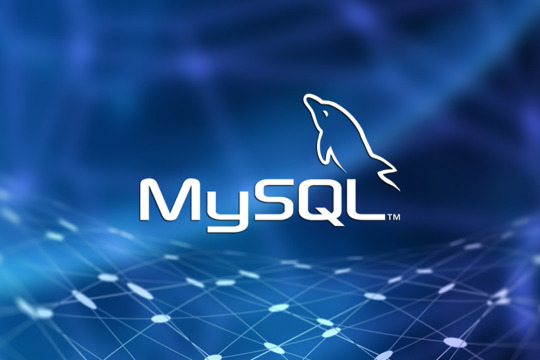
What is MySQL?
MySQL is a freely available open source Relational Database Management System (RDBMS) that uses Structured Query Language (SQL). SQL is the most popular language for adding, accessing and managing content in a database. It is most noted for its quick processing, proven reliability, ease and flexibility of use.
What is a naming convention?
In computer programming, a naming convention is a set of rules for choosing the character sequence to be used for identifiers that denote variables, types, functions, and other entities in source code and documentation.
General rules — Naming conventions
Using lowercase will help speed typing, avoid mistakes as MYSQL is case sensitive.
Space replaced with Underscore — Using space between words is not advised.
Numbers are not for names — While naming, it is essential that it contains only Alpha English alphabets.
Valid Names — Names should be descriptive of the elements. i.e. — Self-explanatory and not more than 64 characters.
No prefixes allowed.
Database name convention
Name can be singular or plural but as the database represents a single database it should be singular.
Avoid prefix if possible.
MySQL table name
Lowercase table name
MySQL is usually hosted in a Linux server which is case-sensitive hence to stay on the safe side use lowercase. Many PHP or similar programming frameworks, auto-detect or auto-generate class-based table names and most of them expect lowercase names.
Table name in singular
The table is made up of fields and rows filled with various forms of data, similarly the table name could be plural but the table itself is a single entity hence it is odd and confusing. Hence use names like User, Comment.
Prefixed table name
The table usually has the database or project name. sometimes some tables may exist under the same name in the database to avoid replacing this, you can use prefixes. Essentially, names should be meaningful and self-explanatory. If you can’t avoid prefix you can fix it using php class.
Field names
Use all above cases which include lowercase, no space, no numbers, and avoid prefix.
Choose short names no-longer than two words.
Field names should be easy and understandable
Primary key can be id or table name_id or it can be a self-explanatory name.
Avoid using reserve words as field name. i.e. — Pre-defined words or Keywords. You can add prefix to these names to make it understandable like user_name, signup_date.
Avoid using column with same name as table name. This can cause confusion while writing query.
Avoid abbreviated, concatenated, or acronym-based names.
Do define a foreign key on database schema.
Foreign key column must have a table name with their primary key.
e.g. blog_id represents foreign key id from table blog.
Avoid semantically — meaningful primary key names. A classic design mistake is creating a table with primary key that has actual meaning like ‘name’ as primary key. In this case if someone changes their name then the relationship with the other tables will be affected and the name can be repetitive losing its uniqueness.
Conclusion
Make your table and database names simple yet understandable by both database designers and programmers. It should things that might cause confusion, issues with linking tables to one another. And finally, it should be readable for programming language or the framework that is implemented.
#MySQL#DatabaseManagement#SQL#NamingConventions#RelationalDatabase#DatabaseDesign#CodingStandards#TableNaming#FieldNaming#DatabaseSchema#ProgrammingTips#DataManagement#CaseSensitivity#PrimaryKey#ForeignKey#DatabaseBestPractices#OpenSource#DatabaseOptimization#MySQLTips#DataStructure
0 notes
Text
PHP Static Variables
What is a Variable?
Variables in a program are used to store values or data that can be reused later in the code. Think of them as containers for numbers, characters, strings, memory addresses, and more. PHP has its own specific
rules for declaring and using variables:
All PHP variable names start with a dollar sign ($), followed by the variable name.
Variable names can be long and descriptive (e.g., $factorial, $even_nos) or short (e.g., $n, $x).
Variable names can contain alphanumeric characters and underscores (a-z, A-Z, 0-9, and _), but cannot begin with a number.
Constants are like variables whose values cannot change. They are also case-sensitive.
Assignment in PHP is done using the = operator. The variable is on the left, and the value or expression is on the right.
PHP is a loosely typed language, meaning you don't have to declare the type of a variable-its inferred based on the value assigned.
PHP variables are case-sensitive ($sum and $SUM are different).
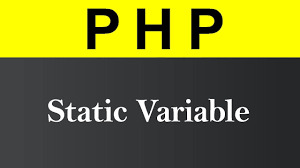
0 notes